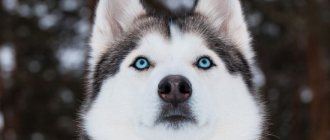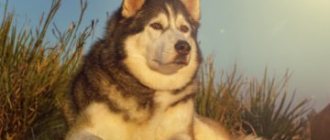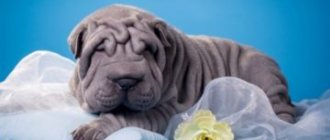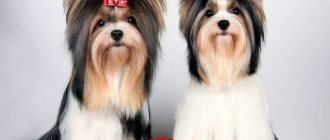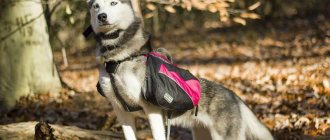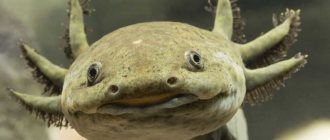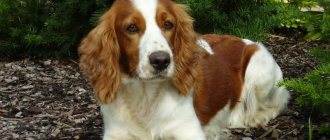Incredibly beautiful, smart, kind, sensitive and loving dogs of the Siberian Husky breed are the dream pets of many animal lovers. And this is truly a very attractive breed in every sense. But huskies require special treatment and care. In order for dogs to bring only joy to your home and become loyal human companions for many years, you need to know how to care for a husky.
In this material we will talk in detail about what caring for a husky consists of, what are the rules for keeping puppies and adult dogs of this breed, and whether a husky can live in a city apartment.
Contents in the apartment
There is an opinion that huskies should not be owned in a city apartment:
- Northern sled dogs love space and cold. The apartment suffers from heat and cramped conditions.
- Aviary animals shed in spring and autumn for 3–4 weeks. In indoor dogs, biological rhythms are disrupted and hair falls out all year round.
- Huskies cannot be left alone. They chew things and furniture, tear off wallpaper and floors.
Meanwhile, many owners managed to cope with difficulties and accumulated positive experience of keeping a husky in a city apartment:
- According to the observations of the owners, dogs normally tolerate the heating season and summer heat. The double coat protects animals from overheating. The light fluffy undercoat together with the guard hairs form an air layer. It does not allow heat and cold to pass through, creating a comfortable temperature at the surface of the skin.
- In summer, at temperatures of 30℃ and above, both animals and people suffer. At home, it is useful to turn on the air conditioner and additionally lay out a cooling mat for your pet.
- Huskies do not shed more than other breeds with thick coats. If you brush it regularly with a furminator, the hair will not fly all over the house.
- The issue of cramped space is controversial. Huskies need a loving, attentive owner. If the owner disappears 12 hours a day at work, then it makes no difference to the dog where to sit locked up - in an enclosure or in an apartment.
- The behavior of a husky depends on the owner. Adequate owners hide shoes, clothes, remote controls, phones and other things away. From an early age, the puppy is accustomed to “chew” toys, rewarded for every contact with them.
- On walks, the dog is allowed to throw out its accumulated energy. They select such a level of physical activity that there is no strength or desire left to organize pogroms.
Ideal order and cleanliness in the house is difficult to maintain with any dog, even a small breed.
Walking and exercise
For sled dogs, the load should be all year round. If it is not possible to do exercises in a harness, then walking on a leash can successfully replace them. Naturally, the age of the dog is taken into account. There are several important principles:
- in summer, walks should be in the cool part of the day to prevent heat stroke;
- duration from 1 to 4 hours, but it is better to devote more time to walks;
- A special feature of caring for a Siberian Husky involves walking without a leash so that the dog can enjoy freedom. If this is not possible, then a long leash will come to the rescue;
- regular exercise.
How to walk with a husky
The puppy begins to be taken outside after the first two-stage vaccination, from about 3 months. They are accustomed to the collar and leash in advance, wearing it at home for 15 minutes a day. Until contact is established and the command “Come to me” is firmly mastered, they are not allowed off the leash.
For a puppy, being outside opens up a new world of sounds, smells, strangers and dogs.
Even huskies trained to call often get carried away and run away. The only way to eradicate a bad habit is to become interesting to your dog.
To release the energy of huskies, measured walking is not enough; they need physical and mental exercise:
- Intensive training: learning basic commands, tricks.
- Jogging behind the owner's bike.
- Skiing.
- Driving loads with sledges and sleds.
It is a common belief that you need to run 10 km a day with a Husky. This is true for sporting dogs that are being trained for competition. Domestic huskies are different, not everyone likes to cover kilometers and carry loads. Running is completely replaced by intensive training of active teams and active games.
Huskies love active walks.
Two walks a day for 15 - 30 minutes are clearly not enough for a husky. Usually they spend from 3 to 5 hours a day outside, but for a dog it is not the duration of walks that is more important, but the intensity of the load.
Read on the topic: The real story of the feat of Togo and Balto, the leaders of the teams who saved the city from the epidemic.
A little history
The Husky breed was developed naturally over thousands of years by the inhabitants of the Far North - the Chukchi. According to physiological characteristics, it is a relative of the well-known Siberian husky (but not its variety). Huskies were used by the Chukchi mainly as sled dogs.
Unfortunately, unlike the husky, after the 17th year this breed was recognized in our country as having no prospects. And therefore, no attention was paid to her at all. The only thing that saved the husky from extinction was that even before the revolution, several of these dogs were taken from Kamchatka by the Americans. That is why the breed was registered not in Russia, but in the USA.
Living in a private home
In a country house it is easier for the owner and more comfortable for the dog. Huskies are not afraid of the cold and live quietly outside all year round. Before the pet arrives, the area is fenced off with a well-buried fence no less than 1.85 m high. Huskies know how to climb over fences and are skilled at digging.
If a husky decides to run away, obstacles will not stop him.
A spacious enclosure made of stainless steel is built in a shaded area:
- A canopy is installed on top to protect from sunlight and precipitation.
- At least 2 walls are left open so that the home is well ventilated.
- A recreation area is arranged inside: a booth or bedding.
- Set out bowls for food and water.
Huskies are not chained to guard the house. They are too good-natured towards strangers and will never become vigilant watchmen.
Aviary dogs also need walks, intensive training or sports activities. If the pet is released onto the property, then bad habits are taken into account: huskies like to dig holes in beds and flower beds, and hunt poultry and small animals.
Features of training
Proper upbringing from an early age is something that Husky dogs definitely need. The care and maintenance of these large, intelligent dogs requires training. If enough attention is not paid to raising a puppy, it will grow up completely uncontrollable. Love of freedom and the desire to lead in everything and everywhere are literally in the blood of these northern dogs.
When starting to train a puppy, you should remember that a husky is, first of all, not a service dog, but a working dog. For example, she will happily take children or even the owners themselves on a sled on her own, without any training. But at the same time, it will not be possible to develop aggressiveness towards strangers in a dog by any means.
Most often, husky training begins at 2-3 months. The training program is chosen so that the dog’s training is as interesting as possible. Huskies should not be punished for not following commands during classes. Much better results with these dogs can be achieved using praise.
When training, the commands themselves should be given to the husky in a clear, authoritative, calm voice. You should be persistent during training. However, we must not forget that these northern dogs respond much better to requests than to orders.
Proper care of a husky puppy requires punishment only in the following cases:
- manifestations of aggression towards the owner;
- committing actions that are dangerous for the dog itself;
- manifestations of aggression towards other dogs.
Under no circumstances should you beat a husky. The following technique is usually used as punishment:
- the dog is picked up by the withers;
- they press her to the floor so that she cannot move;
- After the dog stops resisting and relaxes, he is released.
You should definitely use some treats as a reward during training. You should praise dogs in an even, soft voice. These dogs absolutely cannot stand shrill intonations.
Grooming
Husky wool repels water and dirt due to natural lubrication and a reduced number of scales on the surface of the hair.
Dogs are bathed with zoo shampoo no more than 2 times a year. Human detergents are drying and irritating to pets' skin. The rest of the time, wash off the dirt with cool water. From frequent bathing, the hair loses its ability to clean itself, and a dog smell appears.
During shedding, the fur is combed with a furminator every 3 days. The old undercoat is completely removed in 4 – 6 treatments. You will have to use a comb and a slicker brush every day until the end of shedding.
The rest of the time, the coat is combed once every 7-14 days with a furminator or 2-3 times a week with a fine-toothed comb.
Huskies cannot be cut. Dogs with short hair are deprived of a protective layer of air that protects them from cold and heat. Newly growing hair changes its structure. Wool loses its self-cleaning properties and never becomes the same.
Show huskies have points deducted for haircuts. Before shows, the hair on the cheekbones and between the toes is slightly shortened to make the dog look neater.
In hot weather, wool should not be wet. Wet, thick hair interferes with the evaporation of moisture from the skin, creates a greenhouse effect, and disrupts heat exchange. To cool, wipe the groin, stomach, armpits, and face with cool water.
What mistakes should not be made?
This is how Siberian Huskies are trained at home. Raising and caring for the dogs described requires, as you can see, compliance with certain rules. When raising a puppy, you should try to avoid making mistakes that are typical for beginners. These include primarily:
- prohibitions on communication with other dogs;
- carrying the dog in your arms (especially belly first);
- retraining (the husky will not perform an already learned command several times in a row for no apparent reason).
Among other things, a dog of this breed should under no circumstances be allowed to play with household items - old socks, unnecessary slippers, etc. Otherwise, in the future the dog will do the same with new things. Moreover, it is unlikely that it will be possible to wean him from this.
Teeth
A husky puppy's teeth change from 3 to 6-7 months.
Usually, human help is not required; you only need to look into the mouth once every 2 weeks. Sometimes permanent teeth erupt, but milk teeth sit firmly in the gums and do not want to fall out. In this case, the puppy is taken to a veterinary clinic and the children's teeth are removed.
Dogs, like people, develop plaque on their teeth. Over time, it turns into tartar, which causes gum inflammation, mouth odor, and early tooth loss.
Some owners consider mechanical cleaning an optional procedure. Instead, give him pieces of carrot, apple, or dog sticks to chew on to clean his teeth. These methods do not completely remove plaque.
To prevent plaque buildup, teeth are brushed regularly.
The puppy is gradually accustomed to this unpleasant procedure from an early age:
- First, simply massage the gums.
- When the puppy gets used to it and stops resisting, wipe his teeth with a piece of gauze wrapped around his finger.
- Adult Husky teeth are brushed twice a week with a toothbrush and dog toothpaste.
Human toothpaste should not be swallowed or used on animals. Teeth brushing does not replace preventive examinations with a veterinarian dentist.
Ears
Husky puppies' ears stand up very early, at about 6 - 8 weeks.
The main reason for the delay is an unbalanced diet. If they continue to hang by 3 months, the puppy needs vitamin and mineral supplements, especially calcium.
Veterinarians do not recommend deep cleaning of healthy ears: dripping peroxide, chlorhexidine, lotions into the ear canals, or crawling with cotton swabs. Antiseptics disrupt the microflora and increase the secretion of sulfur.
The inner surface of the ears is wiped with a damp gauze swab when dirt accumulates. Only the visible part is treated, the auditory canals are not touched.
Severe ear discharge, plugs, and itching are signs of otitis media or ear mites. Hygienic cleaning will not help here; the dog needs medicinal or acaricidal ear drops, which are prescribed by the veterinarian.
Paws
The claws are trimmed with a nail clipper when they grow to the floor and begin to clatter. The frequency of procedures is determined by yourself. City dogs have their claws partially worn down on the asphalt. If the dog only walks on the ground and grass, they grow back faster and are pruned more often.
Husky claws are cut at an angle, as in the first picture.
The fur between the toes is carefully trimmed. In summer, dirt accumulates between the pads; in winter, ice balls stick and interfere with running. Trimmed paws are easier to wash after walks.
In spring, summer and autumn you need to choose a remedy for ixodid ticks: drops, collar or tablets.
Norms and feeding regime for a puppy and an adult husky
First, they decide on the type of feeding: buy industrial feed or cook it yourself. Different enzymes are responsible for digesting dry kibble and natural foods. With a mixed diet, digestion does not have time to rebuild, food is poorly absorbed, and fermentation begins in the intestines.
The daily amount of dry food is written on the packaging. With natural feeding, you will have to calculate it yourself. The volume of food is determined by body weight:
- For a puppy up to six months, 5 - 7% of weight.
- From 6 months and older 3 – 3.5% of the animal’s weight.
These are average norms; the specific amount of food depends on the animal’s mobility and physical activity. If the ribs cannot be felt, it means the pet is overfed; if they stick out too much, there is not enough food.
Up to 2 months, the puppy is fed 5-6 times a day; as he grows up, the portions increase and the number of feedings decreases:
| Age, months | Number of feedings |
| up to 2 | 5 – 6 |
| 2 – 3 | 4 – 5 |
| 3 – 6 | 4 |
| 6 – 8 | 3 |
| 9 and older | 2 |
Adult dogs are fed twice a day, preferably by the hour: in the morning no earlier than 8-00, in the evening no later than 22-00. The bowl of food is left for 20 minutes, then removed until the next feeding.
Is it possible to put it on a chain?
You can't keep a husky on a chain; he doesn't know how to sit in one place. This option is only suitable for guard breeds. The optimal equipment for restraining your pet is a collar, leash and muzzle for walking. Leather or nylon are suitable for the first collar. The length of the leash is 1.5-2 meters. The size of the collar is suitable if two fingers of the owner fit between it and the pet’s neck. Without a collar, a dog can only be released in a fenced area.
Only sports dogs that run many kilometers in a harness per day can be chained.
Meat
The digestion of northern sled dogs is designed to absorb proteins and fats and practically does not break down carbohydrates. The basis of feeding a husky is meat. Three times a week it is replaced with offal and sea fish.
The share of meat in a husky’s diet is no less than 65–75% or 20–30 g per kilogram of the animal’s weight.
The table lists what kind of meat a Husky can eat:
| Meat | By-products | Fish |
| beef veal chicken turkey horse meat rabbit game pork without fat | scar liver lung kidneys tongue heart kaltyk trachea | cod hake pollock mackerel salmon tuna sea bass halibut |
A dog's digestive system is designed to process chunks of food. Therefore, the meat is not ground or turned into minced meat. The meat is given raw. After heat treatment, beneficial substances are destroyed. To destroy harmful bacteria, pre-freeze for 5 - 7 days.
The share of cereals in a husky’s diet does not exceed 5–10%.
Huskies do not digest porridge and pasta. The rest of the diet is distributed among vegetables, fruits, and dairy products.
To gain weight, buckwheat, rice, and rolled oats are sometimes added. If you overfeed a dog with cereals, problems with the skin and fur begin, the eyes become watery, and the overall tone decreases.
Breed varieties
The term “husky” is usually used to refer to sled breeds common in various regions. The dogs were bred in various territories, thanks to which they received their names:
- Alaskan Husky. There is speculation that they were bred by crossing shepherds, malamutes and even border collies. They have short hair, despite which they feel great even in the most severe cold. Dogs have a balanced, calm character. Can be used as nannies for babies.
- Klee-kai. The variety was developed in America in the 70s and is considered a mini version. An adult reaches no more than 40 cm at the withers and weighs approximately 7 kg. The dogs are quite mobile, active, friendly and smart. Despite its small size, the husky has good health and can boast of longevity.
- Siberian Husky. This is practically the oldest primitive breed. The Chukchi bred them as sled dogs, but rarely used them as hunters. The height at the withers is 50-60 cm. The dogs are incredibly hardy, capable of running hundreds of kilometers, moving small loads.
- Sakhalin Husky. The dog is large in size, hardy, powerful. The height at the withers can reach 70 cm. A distinctive feature is the “collar” around the neck made of rich wool. The Sakhalin representative has a long coat. People rarely choose him as a pet, even despite his love and good nature.
Plant food
Vegetables, fruits and berries are needed as a source of fiber, vitamins, microelements, to cleanse the intestines and form stool. The table contains a list of vegetables that can be given to huskies without fear:
| Vegetables | Fruits and berries |
| carrots zucchini pumpkin cauliflower white cabbage broccoli bell pepper green beans turnip cucumber eggplant sometimes | apple pear banana blueberries strawberry watermelon pulp gooseberries raspberries currants melon |
Vegetables are added to the meat raw, chopped on a grater. Fruits and berries are offered as treats if the dog likes them.
Dairy products
Fermented milk products are given as a separate feeding instead of meat. They improve the composition of the gastrointestinal microflora and enrich the diet with calcium.
Huskies can be given fermented milk products without sugar except sour cream:
- cottage cheese up to 5% fat;
- kefir;
- curdled milk;
- fermented baked milk;
- yogurt without additives.
To enrich the food with vitamins and microelements, it is useful to add to the main dishes:
- raw chicken, quail egg – 3 times a week;
- sunflower, flaxseed oil – 1 teaspoon per serving of food;
- bran;
- greenery.
Always leave a bowl of clean water freely available. The dog will decide for himself how much and when to drink.
